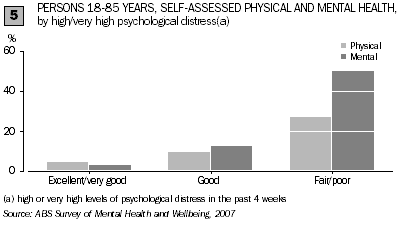SELF-ASSESSED HEALTH
Perception of quality of life
In the 2007 SMHWB, people were asked how they felt about their lives as a whole, taking into account what had happened in the last year and what they expected to happen in the future (the Australian Assessment of Quality of Life instrument). In general, people who perceived the quality of their life to be generally good showed lower levels of psychological distress than those who felt it to be poor.
In 2007, over half the population aged 18-85 (51%) said they were delighted or pleased with the quality of their lives and of these people, less than 3% had high or very high levels of psychological distress. In comparison, 75% of people who perceived their quality of life to be unhappy or terrible had high or very high levels of psychological distress. Almost a third of people who thought the quality of their lives was mixed (both good and poor) had high or very high levels of psychological distress (29%) - over three times higher than the national average of 9.4% (see datacube table 9).
Self-assessed mental health
People were also asked to rate their mental health on a five-point scale from excellent to poor. In 2007, over 10 million people aged 18-85 years rated their overall mental health as excellent or very good. Of these people, 3% had high or very high levels of psychological distress in the past four weeks, which was significantly lower than people who assessed their mental health as fair or poor (50%). Interestingly, people who assessed their mental health as fair or poor were almost equally distributed among the four K10 categories, with 20% having very high levels of distress, 30% having high levels, 29% having moderate levels, and 21% having low levels (see datacube table 10).
Self-assessed physical health
Patterns of psychological distress were similar for people who rated their physical health as good or better. Not surprisingly, however, the relationship between physical health and K10 outcomes was not as marked as that between mental health and K10 outcomes, with far less people who rated their physical health as fair or poor having high or very high levels of distress than people who rated their mental health as fair or poor (27% compared with 50% - see Graph 5, below, and datacube table 11 for more detail).

 Print Page
Print Page
 Print All
Print All
 Print Page
Print Page
 Print All
Print All